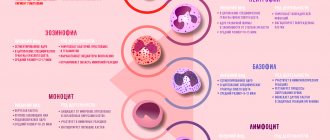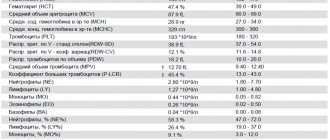Immunoglobulins, or specific protein antibodies, are the “guardians” of our immune system. When an allergen or other foreign biomaterial enters the body, they are the first to react. All immunoglobulins are divided into 5 classes. It is IgE that is responsible for the most common allergic reaction – the one that manifests itself immediately. In addition, it is involved in creating immunity against such types of helminths as: toxoplasma, nematodes, roundworms, trichinella, opisthorchid.
Accordingly, an increase or decrease in immunoglobulin E may indicate either an allergic reaction in the body or infection with helminths. Research is prescribed when there is a need for differentiated diagnosis of these diseases. A referral can be issued by a general practitioner (the child is a pediatrician), as well as an allergist, gastroenterologist, pulmonologist, hematologist or rheumatologist. Most often, an IgE test is prescribed if the patient is suspected of:
- allergic bronchial asthma;
- allergic rhinitis;
- atopic dermatitis;
- eczema;
- hay fever;
- allergies to food or medications;
- helminthic infestation.
Immunoglobulin E (Ig E) general - diagnosis of allergic conditions
Material for research: blood serum.
Research method: IECHL.
Execution time: 1 working day.
Blood collection for general Immunoglobulin E (Ig E) is performed at all BRIGHT-Bio points.
Determination of the content of total Ig E in blood serum is used to diagnose atopic allergic diseases.
Preparation for the study: blood is taken on an empty stomach. At least 8 hours (preferably 12 hours) must pass between the last meal and the test. Juice, tea, coffee (especially with sugar) are not allowed. You can drink water.
The half-life of immunoglobulin class E ( Ig E) is 3 days in blood serum, and 14 days on the membranes of mast cells and basophils. The mechanism of atopic allergic reactions is closely related to immunoglobulins E. They have the ability to quickly fix on skin cells, mucous membranes, mast cells and basophils, therefore free Ig E is present in the blood plasma in small quantities. In addition to participating in type 1 allergic reactions , Ig E also takes part in protective anthelminthic immunity, which is due to the existence of cross-linking between Ig E and the helminth antigen.
Elevated Ig E in children with allergies and hypersensitivity to a large number of allergens are detected more often than in children with hypersensitivity to a small number of allergens, as well as in children whose target organs are not involved in the allergic process. Ig E levels in sick children with hypersensitivity to food and pollen allergens is higher than in children with hypersensitivity to house dust and mold.
In adults, determining the level of Ig E has less diagnostic value than in children. Elevated levels of Ig E are detected only in 60% of patients suffering from atopic bronchial asthma. The highest values of Ig E in the blood are observed with hypersensitivity to a large number of allergens in combination with asthma, dermatitis and rhinitis. With hypersensitivity to one allergen, the level of total Ig E may be within normal limits.
Allergic bronchopulmonary aspergillosis is accompanied by a significant increase in the level of Ig E in the blood. Its concentration is increased in almost every patient with allergic aspergillosis during the period of pulmonary infiltration.
Ig E level in patients with active lung disease excludes the diagnosis of aspergillosis.
When assessing the results of determining total Ig E , it should be borne in mind that in approximately 30% of patients with atopic diseases, the level of this immunoglobulin may be within normal limits.
When diagnosing an allergy, it is not enough to note an increase in total Ig E in the blood. Ig E antibodies against it.
Since the beginning of 2011, the BRIGHT-Bio laboratory has been determining allergen-specific Ig E in blood serum to various allergens grouped in panels.
- Allergy panel Polycheck Pediatric No1 (APPd1)
BRIGHT-Bio is making efforts to expand the list of Allergy panels.
The detection of allergen-specific Ig E (to any allergen or antigen) does not yet prove that this particular allergen is responsible for the clinical symptoms. The final conclusion and interpretation of the results should be made only after comparison with the clinical picture and allergy history data. The absence of specific Ig E in the blood serum does not exclude the possibility of participation in the pathogenesis of the disease Ig E -dependent mechanism, since local synthesis of Ig E and sensitization of mast cells can occur in the absence of specific Ig E in the bloodstream (for example, with allergic rhinitis).
Total immunoglobulins E (IgE) in human serum are gamma globulins produced by B lymphocytes. Their main function is participation in immediate (reagin) type reactions, as well as antiparasitic protection.
Synonyms Russian
Immunoglobulins class E.
English synonyms
Immunoglobulin E, IgE, total (serum).
Research method
Solid-phase chemiluminescent enzyme-linked immunosorbent assay (“sandwich” method).
Determination range: 0.1 - 50000 IU/ml.
Units
IU/ml (international unit per milliliter).
What biomaterial can be used for research?
Venous blood.
How to properly prepare for research?
- Do not eat for 2-3 hours before taking the test; you can drink clean still water.
- Avoid physical and emotional stress for 30 minutes before the test.
- Do not smoke for 3 hours before the test.
General information about the study
Human serum immunoglobulins (Ig, antibodies) are gamma globulins produced by beta lymphocytes. Their main function is the recognition and destruction of antigens. Immunoglobulins consist of 2 heavy (H) and 2 light (L) chains linked by disulfide bridges. Depending on the structure of the H-chains, they are divided into classes: G, M, A, D and E.
Class E immunoglobulins (reagins) are involved in the development of atopic allergic reactions (bronchial asthma, rhinitis, urticaria, atopic dermatitis, etc.). They are able to quickly attach to the surface of mast cells and basophils of the skin and mucous membranes. Therefore, repeated contact of reagin IgE with the antigen (allergen) occurs on the surface of these cells, which leads to the release of vasoactive substances from them (histamine, serotonin, heparin, etc.) and the development of clinical manifestations of type 1 hypersensitivity reaction.
75% of children whose parents suffer from allergic diseases have elevated IgE levels. Among healthy children, elevated levels of total IgE are associated with a 10-fold increase in the risk of developing allergic diseases over the next 18 months compared with children whose blood levels of total IgE are within normal limits. A test for total IgE in blood plasma is used as a screening to identify allergies, but to find the causative allergen, it is necessary to identify specific IgE.
In addition, IgE plays a significant role in the formation of antiparasitic immunity to roundworms, toxoplasma, nematodes, echinococci, trichinella and other parasites, which is due to the ability of IgE to interact with helminth antigens. Therefore, an increase in the level of total IgE in the blood plasma may indicate the presence of parasitic infestation.
What is the research used for?
- For diagnosing allergic diseases and assessing the effectiveness of their treatment.
- For diagnosis, in particular differential, of helminthic infestations.
- To assess the risk of developing allergic reactions in children.
- For the diagnosis of certain immunopathological diseases.
When is the study scheduled?
- If IgE myeloma or other immunopathological diseases are suspected.
- For symptoms of bronchopulmonary aspergillosis.
- For children – when their parents suffer from allergic diseases.
- If a helminthic infestation is suspected.
What do the results mean?
Reference values
| Age | Reference values |
| Newborns | 0 - 1.5 IU/ml |
| Less than 1 year | 0 – 15 IU/ml |
| 1-6 years | 0 – 60 IU/ml |
| 6-10 years | 0 – 90 IU/ml |
| 10-16 years | 0 – 200 IU/ml |
| More than 16 years | 0 - 100 IU/ml |
Reasons for increased levels of total IgE
- Parasitic infestations (ascariasis, intestinal nematodosis, echinococcosis, hookworm disease, amoebiasis, helminth larval migration syndrome).
- Allergic bronchopulmonary aspergillosis.
- Allergic diseases caused by IgE antibodies: atopic (atopic bronchial asthma, allergic rhinitis and sinusitis, atopic dermatitis, drug and food allergies) and anaphylactic (anaphylaxis, urticaria, angioedema).
- Immunopathological diseases (IgE myeloma, periarteritis nodosa, hypereosinophilia syndrome, dysplasia and aplasia of the thymus (DiGeorge syndrome), Wiskott-Aldrich syndrome, hyper-IgE syndrome and recurrent pyoderma (Job-Buckley syndrome), pemphigus (Neumann syndrome), reaction "graft versus host".
Reasons for reducing the level of total IgE
- Hereditary, sex-linked or acquired hypogamma-globulinemia.
- Ataxia-telangiectasia.
- Primary or secondary immunodeficiencies.
What kind of analysis is this
A test for general immunoglobulins E in the blood is used to diagnose allergies, but to search for the causative allergen, immunoglobulins E specific to it are identified. IgE, contained in free form in the blood serum, makes up 0.002% of all antibodies. When interpreting the indicators of total immunoglobulin ig e, allergists at the Yusupov Hospital take into account a number of factors:
- in approximately 1/3 of patients with atopic diseases, the level of total IgE does not exceed the norm;
- some patients with bronchial asthma have increased sensitivity to only one antigen, as a result of which their level of total immunoglobulin E may be within normal limits, while specific immunoglobulins E and skin test results will be positive;
- the concentration of total immunoglobulin E also increases with helminthic infestation, bronchopulmonary aspergillosis and some forms of immunodeficiency and normalizes after treatment;
- angioedema and chronic recurrent urticaria are not mandatory indications for determining total immunoglobulin E, since in most cases they are non-allergic in nature;
- antibodies of other classes that are specific for a given allergen may cause false negative results;
- exceptionally high concentrations of total IgE immunoglobulin may be due to nonspecific binding to various antigens.
What can affect immunoglobulin G?
It is important to know that during intense muscle loads, as well as psychological stress, the level of immunoglobulin G can physiologically increase. In addition, immunization in the last 6 months or taking medications may increase the level.
Agents that increase the concentration of immunoglobulin G:
- valproic acid;
- carbamazepine;
- phenytoin;
- chlorpromazine;
- penicillamine;
- dextran;
- oral contraceptives;
- methylprednisolone;
- gold preparations;
- estrogens.
The level of immunoglobulin G can be reduced by:
- burns received;
- radiation exposure;
- taking cytostatics and immunosuppressants;
- intestinal pathologies that are accompanied by protein loss, for example, ulcerative colitis, Crohn's disease;
- renal failure, nephrotic syndrome.
Function of immunoglobulin IgG
Immunoglobulins G deactivate viral and bacterial toxins and trigger complement-fixing reactions and phagocytosis. Due to their small molecular weight, they quickly and easily enter the extracellular space, where they perform a protective function. Immunoglobulins G are able to penetrate the placental barrier and enter the blood of the fetus from the mother's blood.
Antibodies are part of the humoral immune response; they act very specifically, since they are always directed against a specific antigen. Their purpose is to participate in immune reactions. Immunoglobulins form immune complexes with antigen molecules, activate the complement system and cause inflammatory reactions. This aims to neutralize the irritant and safely remove it from the body.
Each class of antibodies has different structural properties, so they perform specialized functions. In particular, immunoglobulin G is capable of:
- neutralize microorganisms;
- prevent relapses of diseases, for example, mumps, chickenpox, measles, rubella;
- protect the fetus.
The study is recommended for:
- Food allergies;
- Drug allergies;
- Allergies to pollen;
- Ascariasis;
- Intestinal nematode;
- Echinococcosis;
- Amoebiosis;
- Hookworm;
- Bronchial asthma;
- Rhinitis;
- Sinusitis;
- Dermatitis;
- Hives;
- Quincke's edema;
- High level of eosinophils;
- Allergic bronchopulmonary aspergillosis;
- IgE myeloma;
- DiGeorge syndrome;
- Nodular periarthritis;
- Wiskott-Aldrich syndrome;
- Jobe-Buckley syndrome;
- Neumann's syndrome.
Method:
Enzyme-linked immunosorbent assay (ELISA).
Sensitivity:
Not less than 2.5 IU/ml.
Material for research:
Blood serum.
IgG during pregnancy
Immunoglobulins are a natural component of blood plasma. They can cross the placental barrier. There are receptors for IgG on the surface of the trophoblast; they combine and transfer immunoglobulins from the mother’s blood directly into the fetal blood. Thus, this mechanism becomes a passive defense of the child against infections. The fetus's immune system has not yet formed, so maternal antibodies come to the fore. When the mother's antibodies are lacking, doctors prescribe intravenous immunoglobulin G.
IgG is elevated
An increase in the level of immunoglobulin G indicates that an acute or chronic infectious process is beginning in the human body. Immunoglobulins may increase in the following cases:
- whooping cough;
- diphtheria;
- scarlet fever;
- measles;
- rubella;
- chicken pox;
- tuberculosis;
- mononucleosis;
- hepatitis;
- cirrhosis of the liver;
- lupus erythematosus;
- rheumatic fever;
- rheumatoid arthritis;
- helminthic infestations;
- acute and chronic pathologies of the pulmonary, urogenital and intestinal systems;
- recovery period after an infection;
- sarcoidosis;
- cystic fibrosis;
- Waldenström's disease;
- chronic lymphocytic leukemia;
- multiple sclerosis;
- syphilitic damage to the brain or spinal cord;
- severe allergies;
- AIDS, HIV;
- development of oncology.
Normal value for immunoglobulin G
The norm of immunoglobulin G for newborns is 3.97–17.65 g/l. This indicator is due to the fact that the body of a child who has just been born still uses antibodies received from the mother.
In the first year of a child’s life, he begins to produce his own antibodies. At this age, the normal immunoglobulin level for boys is 3.97–17.65 g/l, and for girls – 3.91–17.37 g/l. Norm up to two years: for boys – 4.75–12.1 g/l, for girls – 4.88–12.26 g/l.
Then the amount of immunoglobulins in the blood reaches the same level as in adults. For boys and men, the norm is 5.4-18-22 g/l, for girls and women - 5.52-16.31 g/l.
Preparation
The IgE immunoglobulin test is carried out strictly on an empty stomach. For the study, nurses at the Yusupov Hospital collect venous blood, observing the rules of asepsis and antiseptics. Before the test, it is not recommended to eat food for 10-12 hours, and fatty foods and alcohol should be excluded from the diet one day before the test. You can drink clean still water.
During the several days preceding the study, patients are not given an ultrasound examination, IVs are not placed, and X-rays are not taken. They are not recommended to visit the solarium, sauna or sunbathing. 2-3 days before the study you need to stop playing sports and fitness. The IgE immunoglobulin test is carried out within 3 days. The results of the study in complex cases are discussed at a meeting of the expert council. Doctors at the Yusupov Hospital make a collective decision on further treatment tactics for the patient.







